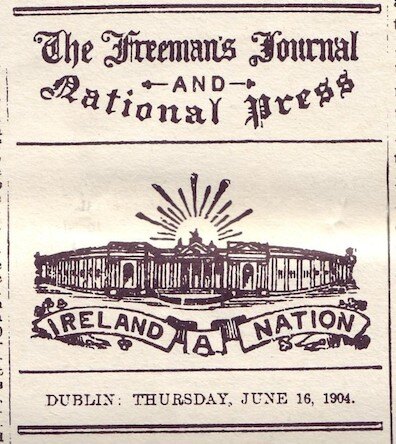The Joyce Project : Ulysses : Home rule sun
Home rule sun
Home rule sun
In Brief
The logo of the morning newspaper that Bloom works for, the Freeman's Journal, did indeed show "a homerule sun rising up in the northwest from the laneway behind the bank of Ireland," as he thinks in Calypso. Arthur Griffith's witty observation of that fact is consistent with the spirit of irreverent mockery that Dubliners bring to their urban landmarks and even to the most sacred subjects. But it also expresses some particular nationalist disdain for this newspaper.
Read More
Even if the geography was wrong, there were good iconographic reasons for the composition of the image. The Freeman's Journal was a leading nationalist newspaper, with a history of espousing Irish independence that stretched back for nearly 150 years. And "the bank of Ireland" was not chosen as a site for the rising of the "homerule sun" because of its commercial symbolism. This grand building in the heart of Dublin was the meeting place of the Irish parliament until that body was abolished by the Act of Union in 1800, after which (now useless) it was sold to the Bank of Ireland. Its splendid facade faces southeast, so the creator of the image had little choice but to place his symbolic sun where he did.
But in the later 19th century the Freeman's editorial positions had become more conservative, and it had come to be associated with the intransigent status quo. The paper consistently gave more opposition than support to Charles Stewart Parnell's Home Rule movement in the 1870s and 80s. Different anti-Parnellite factions strugged for control of the paper after its 1892 merger with the National Press, and by 1904 the editor, Thomas Sexton, had largely renounced the cause of parliamentary reform.
Griffith's joke, then, probably reflects more than simply the irreverent spirit of Irish wit. As an ardent and active nationalist who headed his own newspaper, The United Irishman, and who eventually became the first President of the Irish Free State in 1922, Griffith undoubtedly shared the jaded view of the Freeman held by many Dubliners. To Myles Crawford (affectionately) and the Citizen (contemptuously), it is "the old woman of Prince's street."
